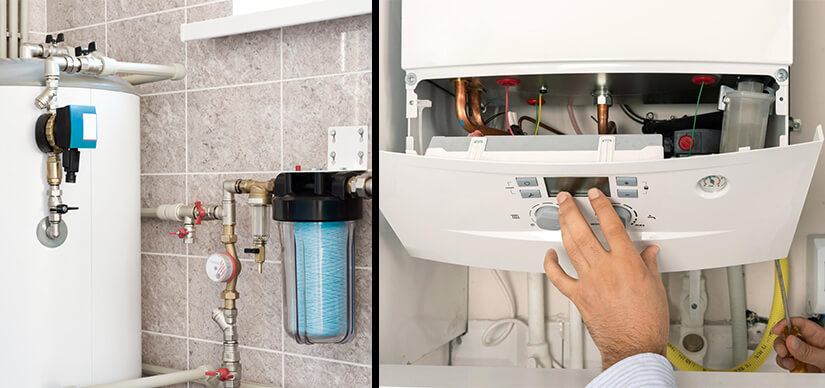Common Causes Of Water Heater Malfunctions And How To Fix Them
If you’ve ever experienced a water heater malfunction, you know how disruptive it can be. Fortunately, many of the most common causes of water heater malfunctions can be fixed with minimal effort and cost.
In this blog post, we’ll explore the top causes of water heater malfunctions, as well as how to fix them.
Whether you need water heater repair or water heater installation in Riverside, this guide will help you troubleshoot the issue and decide how to proceed.
Heating Element Failure
The heating element in your water heater is responsible for warming the water. Assuming the warming heater falls flat, your water won’t be adequately hot, or it may not warm up by any means.
Side effects of a malfunctioning water heater may include an absence of boiling water, water that isn’t sufficiently hot, or odd clamors coming from the tank.
To fix a faulty heating element in your water heater, you want to replace the component.
This process includes switching off the power or gas supply to the water heater, draining the tank, removing the old warming component, and installing the new one.
Leaks
Leaks can occur in a water heater for a variety of reasons, including a faulty seal, an overfilled tank, or broken pipes. Depending on the location of the leak, this can be a serious problem.
If you spot water dripping from your water heater, it’s important to act quickly and contact a professional plumber to assess the situation.
To determine the source of the leak, a technician may use pressure testing to inspect the plumbing lines and the tank.
In some cases, replace the entire water heater if the leak is caused by a cracked tank or faulty parts. If the leak is coming from the plumbing lines, however, the plumber can simply fix or replace the pipe.
No matter the cause, it’s important to address leaks quickly to avoid further damage and possible flooding in your home.
Water Discoloration
If you find that the water coming from your water heater is discolored, it could be a sign of a serious issue.
The color of the water should be a consistent blue or clear depending on your location, and any other colors may indicate sediment or rust from your tank.
If you’re experiencing this, contact a professional to check your water heater installation in Riverside.
Depending on how old the unit is, you may need to replace it or at least have it serviced to prevent further damage.
Your technician can also provide a thorough water heater repair in Riverside to identify the source of the discoloration and correct it.
Odd Noises
Odd noises coming from your water heater can be an indication of a problem. This could include popping, banging, or sizzling sounds.
It is important to address these noises as soon as possible, as they may be signs of an issue with the pressure and temperature relief valve or the sediment buildup in your tank.
If you’re hearing unusual noises, you should contact a professional water heater repair service in Riverside to assess the situation.
Doing so will help prevent more extensive damage to your water heater and ensure it continues to operate safely and efficiently.
Additionally, if your water heater is more than 8-10 years old, it might be time to replace it with a new water heater installation in Riverside.
A leaking Pressure Relief Valve
A leaking pressure relief valve is a common issue with water heaters.
The pressure relief valve is a safety device that is designed to open and release pressure if the pressure in the tank exceeds a certain level.
If the pressure relief valve is leaking, it may be a sign that the valve is defective, damaged, or simply needs to be replaced.
Here are some steps you can take to address a leaking pressure relief valve:
- Put off the power or gas supply to the water heater.
- Turn off the cold water supply to the water heater.
- Locate the pressure relief valve. It is typically located on the top or side of the tank and has a lever or handle.
- Place a bucket or container under the pressure relief valve to catch any water that may be released.
- Lift the lever or handle on the pressure relief valve to release any pressure that may have built up in the tank. If water continues to leak after releasing the pressure, the valve may be defective or damaged.
- Check the valve for any signs of damage or corrosion. If the valve is damaged or corroded, it will need to be replaced.
If the valve appears to be in good condition, try flushing the tank to remove any sediment buildup that may be causing the pressure relief valve to leak. Flushing the tank involves draining the tank and refilling it with cold water.
After flushing the tank, turn the power or gas supply back on, followed by the cold water supply.
Monitor the pressure relief valve to ensure that it is no longer leaking.
It could be required to replace the valve if the leakage persists.
Thermostat Issues
The thermostat in your water heater controls the temperature of the water. If the thermostat is not working correctly, your water may not be hot enough, or it may be too hot.
Symptoms of thermostat issues include water that is too hot or not hot enough, strange noises coming from the tank, or discolored water.
To fix thermostat issues in your water heater, you need to replace the thermostat. This process involves turning off the power or gas supply to the water heater, draining the tank, removing the old thermostat, and installing the new one.
Sediment Buildup
Over time, minerals and sediment can accumulate at the bottom of your water heater tank. This buildup can cause damage to the tank and decrease the efficiency of the heating element.
Symptoms of sediment buildup include reduced hot water supply, strange noises coming from the tank, and discolored water.
To fix sediment buildup in your water heater, you need to drain the tank and flush out the sediment. This process involves turning off the power or gas supply to the water heater, connecting a hose to the drain valve, and draining the tank.
Once the tank is empty, fill it with cold water and drain it again to remove any remaining sediment.
Preventative Measures to Avoid Water Heater Malfunctions
Preventative measures can help you avoid water heater malfunctions, extend the lifespan of your water heater, and save you money in the long run.
Here are some steps you can take to avoid problems:
Regular Maintenance
One of the most important preventative measures is to perform regular maintenance on your water heater.
Flush your water heater tank at least once a year to remove sediment buildup. This process involves turning off the power or gas supply to the water heater, connecting a hose to the drain valve, and draining the tank.
Once the tank is empty, fill it with cold water and drain it again to remove any remaining sediment.
Temperature Checks
It’s a good idea to check the temperature of your water regularly. You can use a thermometer to test the temperature of the water at the tap.
The recommended temperature for your water heater is between 120 and 140 degrees Fahrenheit. If the temperature is too high, you may need to adjust the thermostat.
Insulation
Insulating your water heater can help reduce heat loss and improve the efficiency of your water heater.
You can purchase an insulation blanket from a home improvement store and wrap it around your water heater.
Make sure to follow the manufacturer’s instructions and leave the thermostat and controls accessible.
Professional Inspection
Hiring a professional plumber in Riverside to inspect your water heater can help identify any potential issues before they become major problems.
A plumber can check for leaks, test the pressure relief valve, and perform other maintenance tasks that you may not be able to do yourself.
Conclusion
There are several common causes of water heater malfunctions, including sediment buildup, heating element failure, thermostat issues, and leaks.
By identifying the symptoms and fixing these issues, you can ensure that your water heater is working efficiently.
By following these preventative measures, you can help avoid water heater malfunctions and ensure that your water heater is working efficiently.
If you do experience any issues with your water heater that is beyond your handling, it’s important to contact a professional for your water heater repair in Riverside.


